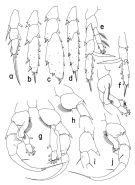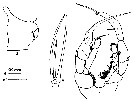|
|
 |
|
Calanoida ( Order ) |
|
|
|
Arietelloidea ( Superfamily ) |
|
|
|
Heterorhabdidae ( Family ) |
|
|
|
Heterorhabdus ( Genus ) |
|
|
| |
Heterorhabdus habrosomus Park, 2000 (F,M) | |
| | | | | | | Syn.: | Heterorhabdus abyssalis: Tanaka, 1964 a (p.2, figs.M, no F);
Heterorhabdus proximus: Bradford, 1971 a (p.126, figs.F,M);
Heterorhabdus (Heterorhabdus) proximus : Bradford-Grieve,1999 b (p.84, figs.F,M, figs.175, 191) | | | | Ref.: | | | Park, 2000 (p.117, figs.F,M, Rem.) |  issued from : T. Park in Bull. Scripps Inst. Oceanogr. Univ. California, San Diego, 2000, 31. [p.236, Fig.84]. Female: a, habitus (left side); b, c, urosome (left, dorsal, respectively); d, e, forehead (left, dorsal, respectively); f, genital somite (left); g, genital somite from different specimen (left); h, genital somite (ventral); i, left Mx2 (posterior); j, right Mxp (anterior). gfl = genital flange. Nota: Prosome 73% length of body and about 2.4 times length of urosome. Cephalosome 46% length of prosome. Forehead rounded, produced ventrad into a relatively long conical rostrum bearing 2 slender filaments. Dorsally, midanterior tubercular process of forehead (Fig.84-e) more or less truncate, bearing suprafrontal sensillae. Posterolateral corner of prosome rounded, overlapping anterior 1/6 length of genital somite. Dorsally, genital somite widest at middle, typically with a length-width ratio of 100:75, with smootly curved lateral swellings extending posteriad to 87% length of somite from anterior end. Laterally, genital somite longer than deep, typically with a length-depth ratio of 100:89, with a low dorsal hump slightly anterior to midpoint and more or less rounded genital prominence extending far short to posterior end of somite. Genital flange smoothly arched. Genital operculum extending to top of genital flange. Ventrally, genital operculum about as long as wide and 62% as wide as somite. Genital field with about 123 pores on right side and 2-6 pores on left side. First 3 urosomal somites armed with spinules along posterior margin. Length ratios of 4 urosomal somites and left caudal ramus 39.1 : 17.4 : 13.1 : 8.7 : 21.7 = 100. Dorsal appendicular seta of left ramus approximately 1.5 times as long as that of right ramus. 4th marginal seta of left ramus much thicker than other marginal setae and longer than body. 3rd marginal seta of left ramus and 3rd and 4th marginal setae of right ramus armed with spines in addition to normal setules. A1 extending beyond posterior end of caudal ramus by its last 1 or 2 segments. Mx2: 2nd seta of 1st lobe about 1/2 length of 1st. Spine of 2nd lobe thick, about as long as 2nd seta of 1st lobe. Small, posterior spine of 3rd lobe about 1/4 length of anterior spine. Posterior subterminal spine of 4th lobe 58% as long as 2nd saberlike spine, which is about as long as 1st. Falcate spine of 5th lobe about 1.3 times length of saberlike spine, with proximal 63% of medial margin serrated with spinules. Falcate spine of 6th lobe with proximal 72% of medial margin serrated with spinules.
|
 issued from : T. Park in Bull. Scripps Inst. Oceanogr. Univ. California, San Diego, 2000, 31. [p.237, Fig.85]. Female: a, exopod of P1 (anterior); b, exopod of P2 (anterior); c, exopod of P3 (anterior); d, exopod of P4 (anterior); e, P5 (anterior); f, exopod of P5 (posterior). Nota: Exopod of P2 anteriorly, 1st segment with 1 pore, 3rd with 4 pores. Exopod of P3, anteriorly, 1st segment with 1 pore, 2nd with 2, and 3rd with 7. Exopod of P4, anteriorly, 1st segment with 1 pore, 2nd with 2, 3rd with 7. P5 anteriorly, exopod with 1 pore on 3rd segment. Male: g, P5 (anterior); h, basipod of left P5 (anterior); i, exopod of left P5 (anterior); j, right P5 (endopod omitted), posterior; k, right P5 (distal exopodal segments omitted), anterior, tilted counterclockwise. Prosome 73% length of body and about 2.6 times length of urosome. Urosome 28% length of body. First 4 urosomal somites armed with spinules along posterior margins. Caudal rami and their setation as in female. Left geniculate A1 similar in details to that of H. spinifrons. All other cephalosomal appendages and P1 to P4 as in female. P5: inner lobe or right basis arising from middle of anteromedial margin of segment, longer than segment, characteristically sigmoid, with a row of stiff setules proximally in addition to a band of setules along its whole medial margin (Fig.85-g). Left basis (Fig.85-h) with smoothly curved medial margin, its distal 2/3 fringed with setules. Left endopod longer than right, each with inner marginal seta on 2nd segment. Medial projection of 2nd segment triangular, its proximal margin set off some distance from proximal end of segment and furnished with setules and its distal margin arising from middle of segment. Outer spine of 2nd segment about at middle of segment. 3rd segment including terminal lobe about 1.7 times length of 2nd, smoothly curved, with outer spine, which is moved mediad by the rotation of exopod, about 1/4 length of segment from proximal end. Terminal spine of 3rd segment about 2/3 length of segment. Left exopod (Fig.85-g), 1st segment about 2/3 length of 2nd, with a rounded tubercular swelling proximally on medial margin; 2nd segment (Fig.85-i) with a long lateral, conical process termionating with outer spine. Measured along medial margin, conical process about 1/3 length of segment and about as long as outer sine; 3rd segment with well-developed inner and outer spines and tapering distally into a long spiniform process. Together with distal spiniform process, 3rd segment making up 70% length of whole exopod.
|
 issued from : J.M. Bradford in N.Z. Jl mar. freshw. Res., 1971, 5 (1). [p.127, Fig.6, d-f]. As Heterorhabdus proximus. Female (from New Zealand): d, genital segment (right side). Male: e, lobe 4 of Mx2; f, P5.
|
 Heterorhabdus hadrosomus Heterorhabdus hadrosomus female: 1 - See key to species groups of Heterorhabdus: ''abyssalis'' Group (p.90, 114). 2 - Genital somite without a conical projection mediodorsally (Fig.84-a, f). 3 - Laterally, genital somite without a tubercular outgrowth posteriorly on dorsal margin (Fig.84-b). 4 - Laterally, genital operculum far short of reaching posterior end of somite (Fig.84-h). 5 - Laterally, right and left genital flanges symmetrical. 6 - Laterally, genital prominence distinctly separate from ventral wall of somite. 7 - Dorsally, as well as ventrally, lateral swellings of genital somite short of reaching posterior end of somite (Fig.84-c). 8 - Laterally, genital prominence far short of reaching posterior end of somite (Fig.84-f). Posterior subterminal spine of 4th lobe of Mx2 (on 3rd segment) longer than 1/2 length of saberlike spine (Fig.84-i).
|
 Heterorhabdus hadrosomus Heterorhabdus hadrosomus male: 1 - See key to species groups of Heterorhabdus: ''abyssalis'' Group (p.90, 114). 2 - Basis of left P5 without a well-developed inner lobe (Fig.85-g). 3 - Basal inner lobe of right P5 armed with normal bristles (Fig.85-g, j). 4 - 3rd exopodal segment of right P5 with a short terminal lobe, much less than 1/3 length of terminal spine (Fig.85-g). 5 - Basal lobe of right P5 arising from medial or anteromedial side of segment (Fig.85-g, j). 6 - 2nd exopodal segment of left P5 with outer spine borne on a conical process (Fig.85-i). 7 - Basal lobe of right P5 sigmoid (Fig.85-g).
| | | | | NZ: | 5 | | |
|
Distribution map of Heterorhabdus habrosomus by geographical zones
|
| | | | | | | Loc: | | | S Atlant. (equatorial, subtropical), SW Indian, Japan (off Tokyo), N Pacif. central, New Zealand
Type locality: 1,34°33'N, 141°55'E.9).
For Park (2000, p.119), the species (often as synonym) demonstrates a circumglobal distribution , however, it was not found in the whole east Pacific, where more samples were examined thanj any other parts of the world's oceans. | | | | N: | 3 | | | | Lg.: | | | (121) M: 3,08-2,34; (399) F: 2,75-2,3; M: 2,5-2,2; (824) F: 2,56-2,16; M: 2,48-2,14; {F: 2,16-2,75; M: 2,14-3,08} | | | | Rem.: | "Abyssalis" Group.
After Park (2000, p.119) This species is unusual in having a sigmoid basal inner lobe on the male right P5.The male was reported by Tanaka (1964) and both the female and male described by Park (1968) from the central North Pacific; both authors referred the species to H. abyssalis (Giesbrecht, 1892). Subsequently, Bradford (1971) found in the southwestern Pacific H. abyssalis of Tanaka (1964) and park (1968) and identified it as H. proximus Davis, 1949. H. abyssalis of Tanaka (1964) and Park (1968) and H. proximus of Bradford (1971a) are the same and differ from both H. abyssalis (Giesbrecht, 1889) and H. proximus Davis, 1949.
The new species differs from H. proximus as originally described by Davis in the following aspects: 1- H. proximus is much larger than H. hadrosomus; 2 - in the male P5 of H. proximus, the basal inner lobe of the right P5 is short, reaching about the distal end of the segment, the terminal spine of the right exopod very short, the terminal spine of the left exopod short, not tapering into a long, needle-like spine; in the male P5 of H. hadrosomus, the basal inner lobe of the right P5 is long, extending beyond the distal end of the segment by 2/3 its length, the terminal spine of the right exopod long, the terminal spine of the left exopod long and tapering into a long needle-like spine..
H. proximus Davis, 1949 is a synonym of H. tanneri (Giesbrecht, 1895), which commonly occurs in the same area and is similar in body size to H. proximus but was not reported by Davis (1949). | | | Last update : 20/05/2017 | |
|
|
 Any use of this site for a publication will be mentioned with the following reference : Any use of this site for a publication will be mentioned with the following reference :
Razouls C., Desreumaux N., Kouwenberg J. and de Bovée F., 2005-2025. - Biodiversity of Marine Planktonic Copepods (morphology, geographical distribution and biological data). Sorbonne University, CNRS. Available at http://copepodes.obs-banyuls.fr/en [Accessed December 24, 2025] © copyright 2005-2025 Sorbonne University, CNRS
|
|
 |
 |






